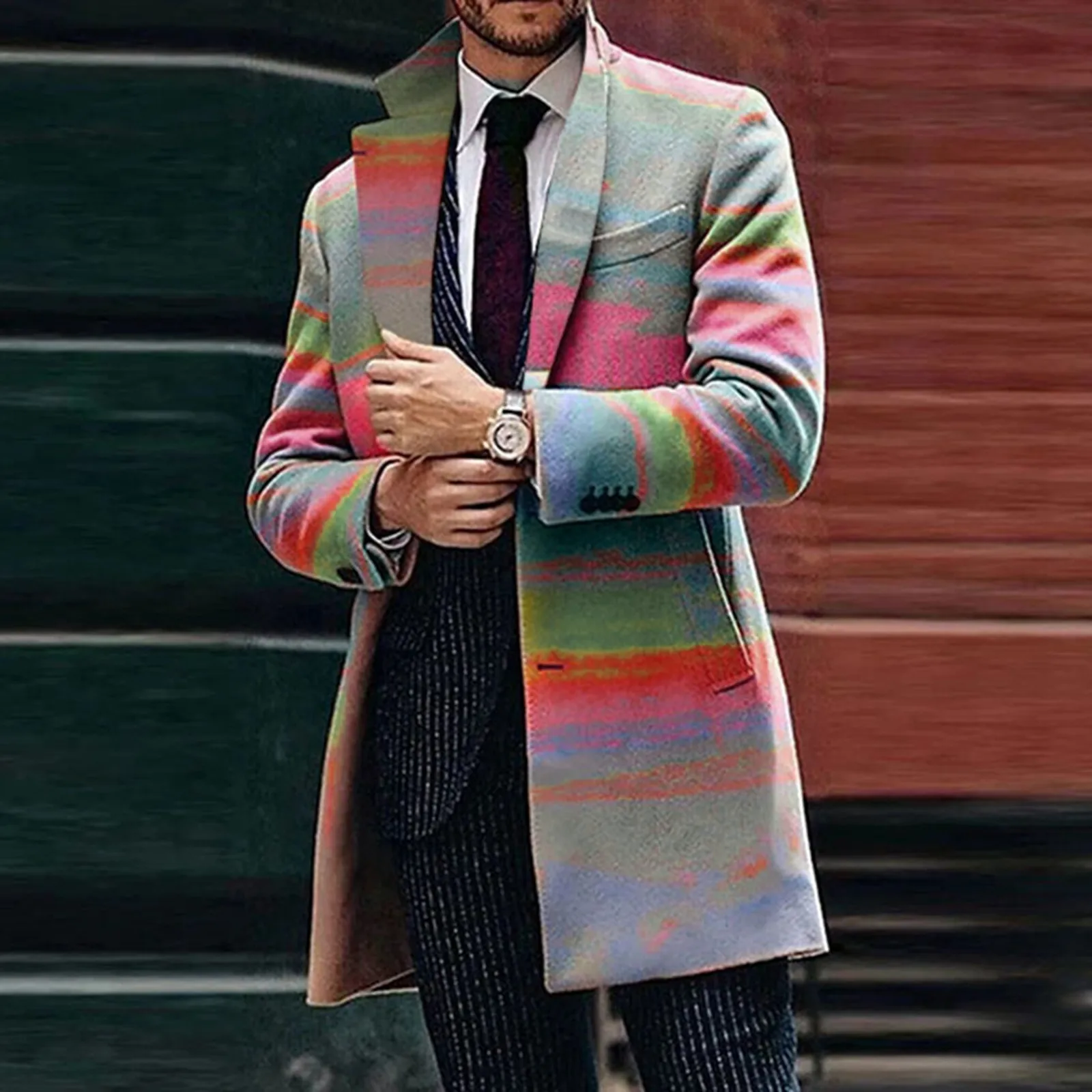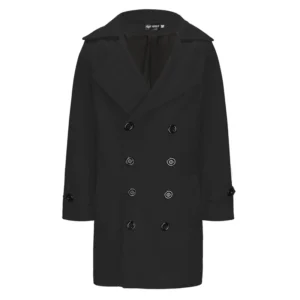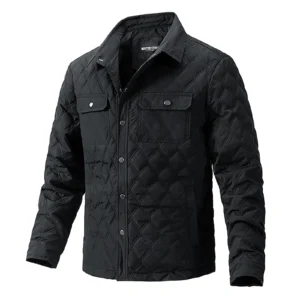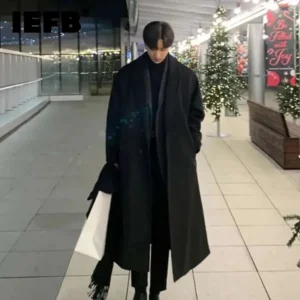Introduction: Why Your Coat Choice Can Make or Break Your Suited Look
The relationship between a suit and the coat worn over it is crucial yet often overlooked. Like a frame to a masterpiece, your outerwear serves as both protection and enhancement for the carefully tailored garment underneath. A well-chosen coat maintains the clean lines and structured silhouette of your suit while adding an extra dimension to your professional appearance.
Conversely, an ill-fitting or inappropriate coat can instantly undermine the sophistication of even the most exquisite suit. Imagine a scenario: Two professionals attend the same meeting in identical high-quality suits, but one wears a sleek overcoat that complements his attire, while the other arrives in a casual, puffy jacket that crumples his suit jacket underneath. The difference in overall impression is immediate and significant.
In this guide, you’ll discover:
– The essential coat styles designed specifically to complement suits
– Critical factors in selecting the perfect coat for various professional settings
– Expert styling techniques to maintain a polished appearance
– Common mistakes to avoid when pairing coats with formal attire
Understanding the right coat length is fundamental to creating a balanced, professional appearance that protects your investment in fine tailoring while making a confident style statement.
Essential Factors for Selecting the Perfect Coat for Your Suit
When shopping for a coat to wear over your business suits, several critical factors determine whether your selection will enhance or detract from your professional appearance.
Proper Fit: Room for Layers Without Bulk
The ideal coat for wearing over suits must provide adequate room for your suit jacket without appearing oversized. When trying on potential options:
– You should be able to comfortably button the coat with your suit jacket on underneath
– Shoulder seams should extend slightly beyond your natural shoulders to accommodate the suit
– Armholes should allow free movement without pulling at the suit sleeves
– The chest should have 2-4 inches of extra room compared to your suit measurement
Length Requirements: Complete Coverage
Length is perhaps the most crucial element in coat-suit pairing. A coat worn over a suit must be long enough to completely cover your suit jacket. The optimal coat length typically falls anywhere from just below the suit jacket hem to just above the knee, depending on the specific style and your height.
Material Selection: Weight, Warmth, and Refinement
Your coat’s material should align with both climate needs and formality requirements:
– Wool and cashmere blends offer excellent warmth with a refined appearance
– Pure cashmere provides exceptional softness but requires more careful maintenance
– Heavier wool (20-24 oz) for colder climates
– Lighter wool (16-18 oz) for moderate temperatures
– Water-resistant treatments add functionality without sacrificing appearance
Color Coordination: Versatility vs. Statement
When building your professional wardrobe, consider these color principles:
– Navy, charcoal, black, and camel offer maximum versatility with most suit colors
– Darker colors generally convey more formality
– Lighter neutrals work well in less formal business environments
– Consider your existing suit collection when selecting coat colors
Formality Matching
The formality of your coat should align with both your suit and the occasions where you’ll wear the combination. Structured coats with clean lines complement formal business attire, while slightly relaxed styles may pair better with business casual suits.
Classic Overcoat: The Gold Standard for Formal Suit Protection
The overcoat represents the pinnacle of formal outerwear designed specifically to complement suits. This timeless garment offers both protection and polish, creating a complete professional image.
Defining Characteristics
- Typically crafted from heavy wool or cashmere (20-24 oz weight)
- Falls between knee-length and mid-calf
- Features structured shoulders and a defined silhouette
- Includes notched or peaked lapels
- Available in single or double-breasted configurations
The single-breasted overcoat offers versatility across a range of professional settings, while the double-breasted version provides additional warmth and conveys greater formality. For daily business wear, the single-breasted option typically proves more practical and adaptable.
When pairing with formal business suits, the overcoat should harmonize rather than compete with your suit. Navy and charcoal overcoats provide nearly universal compatibility, working seamlessly with navy, gray, and black suits. For additional sophistication, consider classic patterns like herringbone that add subtle texture without overwhelming your ensemble.
While primarily designed for fall and winter wear, a quality overcoat represents an investment piece that will serve you for decades when properly maintained. The enduring nature of this formal outerwear option makes it worth allocating a more significant portion of your wardrobe budget to secure a well-constructed example.
Metro Cloak’s collection of men’s overcoats includes options specifically engineered to accommodate tailored suits while maintaining a sleek external appearance.
Topcoat: The Lighter Alternative for Transitional Weather
While often confused with overcoats, topcoats represent a distinct category designed for milder conditions while maintaining professional polish. The key difference lies in both weight and length, with topcoats offering a lighter alternative that still preserves the formality required for business settings.
Key Distinguishing Features:
- Lighter fabric weight (typically 16-18 oz versus 20-24 oz for overcoats)
- Shorter length, usually hitting mid-thigh to just above the knee
- Less structured construction for improved mobility
- Often crafted from finer wool blends allowing for transitional season wear
Topcoats excel during spring and fall when full winter protection isn’t necessary, but professional appearance remains paramount. Their lighter construction makes them less cumbersome during commutes while still providing adequate warmth for moderately cool conditions.
The fabric selection for men’s topcoats typically emphasizes smoothness and drape, with merino wool and cashmere blends being popular choices. These materials allow the coat to move naturally with your suit without creating unwanted bulk or stiffness.
Business professionals who frequently transition between indoor and outdoor environments particularly benefit from the topcoat’s versatility. The lighter weight prevents overheating when moving from cold exteriors to heated office buildings, a common issue with heavier overcoats during moderate weather conditions.
Trench Coat: The Timeless Rain-Ready Classic
Few outerwear pieces have maintained their professional relevance as consistently as the trench coat. Originally designed for military officers in the early 20th century, this iconic style has evolved into an essential business wardrobe component, particularly for professionals navigating rainy conditions.
Defining Elements:
- Double-breasted front closure with ten buttons
- Belted waist creating a defined silhouette
- Distinctive storm flaps and epaulets
- Traditionally crafted from water-resistant cotton gabardine
- Length typically reaching just below the knee
The trench coat’s enduring appeal stems from its perfect balance of functionality and refinement. The water-resistant construction protects suits from rain damage, while the structured design maintains a formal appearance appropriate for business settings.
Modern trench coats are available in various lengths, but when wearing over suits, the traditional longer length offers superior protection by covering the entire suit jacket. This aspect of short vs. long coats becomes particularly important in wet conditions, where keeping your suit dry is essential.
Contemporary versions may incorporate technical fabrics that enhance weather resistance while maintaining the classic silhouette. However, traditional cotton gabardine remains the gold standard for its breathability and natural water-repellent properties when properly treated.
Styling a trench coat with business attire follows specific conventions:
– The belt should be tied rather than buckled for a more sophisticated appearance
– Collar can be turned up during inclement weather without appearing casual
– When temperatures permit, wearing the coat open with the belt tied at the back creates a streamlined silhouette
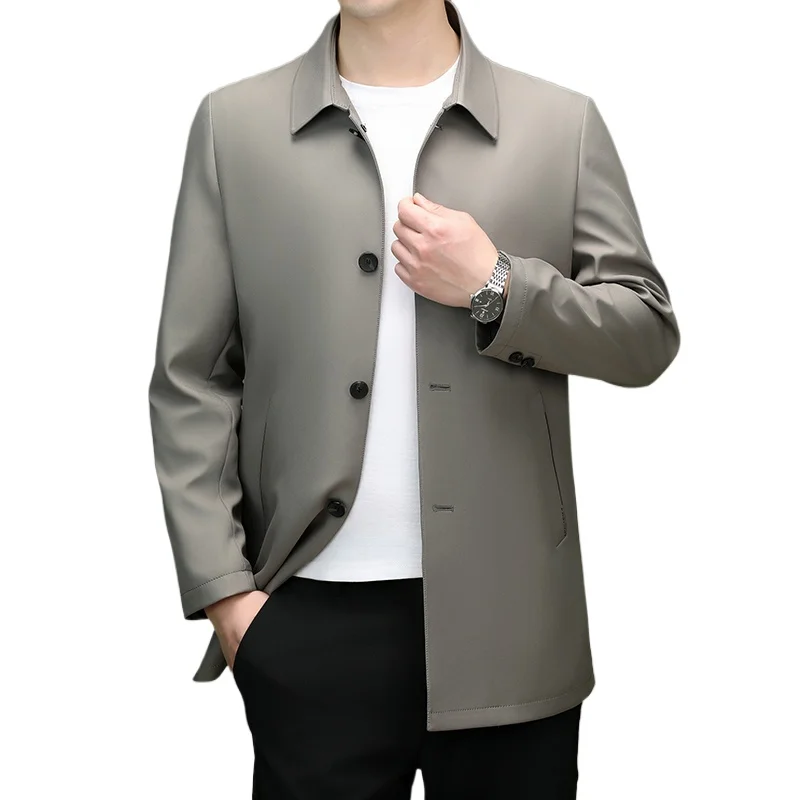
Chesterfield Coat: Refined Elegance for Formal Occasions
The Chesterfield represents perhaps the most formal coat style designed specifically for wear over suits. This distinguished garment combines understated elegance with formal detailing that complements business and ceremonial attire alike.
Distinctive Features:
- Single-breasted front with concealed closure
- Velvet collar in contrasting color (traditionally black)
- Clean, minimalist design without a belt
- Straight cut with slight shaping at the waist
- Typically crafted from fine wool or cashmere
Originally popularized in the mid-19th century, the Chesterfield has maintained its position as the quintessential formal overcoat. Its restrained design philosophy makes it particularly suitable for the most formal business environments and special occasions where sophistication is paramount.
The defining velvet collar serves both functional and aesthetic purposes—originally designed to protect the fabric from hair products when men wore their hair longer, it now stands as a mark of refined tailoring tradition. This subtle yet distinctive detail separates the Chesterfield from standard overcoats.
For suit pairing, the Chesterfield works exceptionally well with formal business attire and classic overcoats for formal wear. The coat’s clean lines complement the structured nature of traditional suits, creating a harmonious overall appearance suitable for executive settings, important business meetings, and formal evening events.
Mac/Raincoat: Streamlined Protection for Professional Settings
For the business professional seeking weather protection with minimal bulk, the Mac (or modern raincoat) offers a refined solution that pairs seamlessly with tailored suits. Distinguished by its clean lines and absence of extraneous details, this style embodies efficient elegance.
Key Characteristics:
- Single-breasted front with concealed or minimal buttons
- Clean, collarless design or small stand collar
- Straight silhouette without belt or gathering
- Typically falls to mid-thigh or knee length
- Crafted from water-resistant cotton, polyester, or technical blends
Unlike the more ornate trench coat, the Mac achieves its sophistication through simplicity. The absence of epaulets, belts, and storm flaps creates a streamlined appearance that transitions smoothly from business formal to business casual environments.
Modern versions often incorporate advanced waterproofing technology without sacrificing the clean aesthetic. Bonded seams, water-repellent treatments, and breathable membranes allow these coats to provide serious weather protection while maintaining a refined appearance suitable for professional settings.
The Mac’s versatility across formality levels makes it an excellent investment for varied business wardrobes. It pairs equally well with traditional wool suits for formal meetings and with more casual sport coats for business-casual offices, offering practical protection without compromising style in either context.
Car Coat: Contemporary Style for Modern Professionals
The car coat represents a more modern approach to business outerwear, offering a shorter alternative that accommodates today’s transportation realities while maintaining professional appropriateness. Originally designed for early automobile drivers who needed protection without the encumbrance of longer coats, this style has evolved into a practical option for urban professionals.
Defining Features:
- Shorter length typically hitting at mid-thigh
- Straight cut with minimal waist suppression
- Designed for ease of movement and sitting
- Often features a concealed placket or clean front
- Available in structured wool or more technical weather-resistant fabrics
The car coat’s primary advantage is its compatibility with contemporary lifestyles—it doesn’t bunch uncomfortably when sitting during commutes and allows for greater mobility throughout the day. This practicality has made men’s car coats increasingly popular among professionals in urban environments.
While the shorter length deviates from traditional suit-covering principles, the car coat can still work effectively with modern, slimmer-cut suits. The key to successful pairing lies in proportion—both the suit and coat should share a similar silhouette, with the coat being slightly more relaxed to accommodate layers.
This style works best in business-casual environments or with suits that have a more contemporary cut. Traditional, fuller-cut suits typically pair better with longer overcoats to maintain proper proportion and coverage.
Professional Styling: Mastering Color and Pattern Coordination
Creating a cohesive relationship between your coat and suit requires thoughtful color and pattern coordination. Rather than matching exactly, the goal is to create harmonious relationships that elevate your overall appearance.
Color Theory Fundamentals
- Complementary colors (those opposite on the color wheel) create dynamic contrast
- Analogous colors (those adjacent on the color wheel) create subtle harmony
- Neutral coats (navy, charcoal, black, camel) offer maximum versatility
- Consider seasonal color theory—darker tones for winter, lighter for transitional seasons
When pairing patterns, follow the principle of scale variation—if your suit features a bold pattern, your coat should display either a subtle pattern or none at all. Conversely, a solid suit provides the perfect canvas for a subtly patterned coat, such as herringbone patterns that add visual interest without overwhelming.
For those building a versatile business wardrobe, consider starting with a foundation of neutral coats—navy and charcoal offer nearly universal compatibility with business suits. As your collection expands, consider adding a camel coat, which provides sophisticated contrast with dark suits while maintaining professional appropriateness.
Remember that lighting conditions impact color perception significantly. Colors that appear complementary in natural daylight might clash under office fluorescents. When possible, evaluate potential coat-suit combinations in lighting conditions similar to where you’ll wear them.

Essential Accessories: Completing Your Overcoat and Suit Ensemble
The right accessories transform your coat and suit combination from merely appropriate to exceptionally refined. These finishing elements should create coherence while adding functional benefits.
Scarves: The Foundational Accessory
- Fine merino or cashmere offers warmth without bulk under coat collars
- Solid colors in complementary or contrasting tones create sophistication
- Simple draping techniques (once around, over-hand knot) maintain professional appearance
- Width should be proportional to your coat’s lapels and your body frame
Gloves: Refined Hand Protection
- Leather represents the most formal and business-appropriate option
- Nappa and kid leather offer suppleness and refined appearance
- Colors should complement your coat and suit (black, brown, navy, burgundy)
- Proper fit allows dexterity without excess material at fingertips
Hats: Weather Protection with Style
- Felt fedoras provide formal protection compatible with business overcoats
- Structured wool caps offer a more contemporary option for less formal settings
- Hat color should harmonize with your coat rather than match exactly
- Proper fit sits securely without appearing too tight or too loose
Coordinated accessories demonstrate attention to detail—a quality highly valued in professional environments. The cohesion between your coat, suit, and accessories conveys intentionality in your appearance, reflecting the same careful consideration you likely bring to your work.
Coats to Avoid When Wearing a Suit: Common Mistakes
Not all outerwear is designed to complement tailored clothing. Certain styles, regardless of quality or brand prestige, fundamentally clash with the structured elegance of suits. Understanding which coats to avoid is equally important as knowing which to select.
Categorically Unsuitable Styles:
- Puffer jackets and parkas: The bulky silhouette and casual materials destroy suit lines
- Hooded technical jackets: Athletic design elements clash with tailored formality
- Denim or trucker jackets: Too casual in both material and length
- Bomber and varsity jackets: Cropped length exposes suit jacket, creating visual discord
- Shearling and casual leather jackets: Rugged texture conflicts with refined suiting
Problematic Length Issues:
Coats that end above the suit jacket hem create an awkward visual interruption, immediately signaling improper pairing. Understanding appropriate coat lengths helps avoid this common mistake.
Formality Disconnects:
Even quality outerwear like technical mountain parkas or premium fleece jackets should be reserved for casual attire. Their design language—regardless of price point—communicates casualness that contradicts the formality of suits.
Borderline cases like leather jackets require careful consideration. While certain streamlined, longer leather coats might work with very casual suits in creative industries, traditional business environments generally call for more conventional wool or cotton outerwear options.
Can You Successfully Wear a Pea Coat Over a Suit?
The pea coat represents one of the most debated outerwear options for suit wearers. This naval-inspired jacket occupies a middle ground between casual and formal, making its appropriateness situation-dependent.
The primary challenges when pairing pea coats with suits include:
– Traditional pea coats often end at hip length, exposing the suit jacket
– The double-breasted design and wider lapels can create bulk over suit jackets
– The nautical heritage communicates a more casual aesthetic than dedicated business coats
However, in certain scenarios, this combination can work effectively:
– When the pea coat is longer, extending beyond the suit jacket hem
– With slimmer-cut suits that create less bulk underneath
– In business-casual environments where slight formality reduction is acceptable
– When the coat features more refined details (higher-quality wool, minimal hardware)
For optimal results, select a pea coat specifically designed to accommodate tailored clothing—look for slightly longer lengths, cleaner lines, and more refined buttons than traditional naval versions.
Mens Double Breasted Pea Coat, Mens Wool Blend Coat, Mens Wool Pea Coat
Price range: $136.84 through $157.36 Select options This product has multiple variants. The options may be chosen on the product pageMens Cashmere Overcoat, Mens Hooded Winter Coat, Mens Wool Blend Coat
Price range: $128.72 through $139.68 Select options This product has multiple variants. The options may be chosen on the product pageMens Black Overcoat, Mens Black Wool Coat, Mens Wool Overcoat
$339.18 Select options This product has multiple variants. The options may be chosen on the product pageMens Double Breasted Pea Coat, Mens Hooded Winter Coat, Mens Quilted Coat
Price range: $81.00 through $108.48 Select options This product has multiple variants. The options may be chosen on the product pageMens Grey Overcoat, Mens Wool Blend Coat, Mens Wool Overcoat
$201.28 Select options This product has multiple variants. The options may be chosen on the product pageMens Herringbone Coat, Mens Long Overcoat, Mens Wool Overcoat
Price range: $197.16 through $203.69 Select options This product has multiple variants. The options may be chosen on the product page
Care and Maintenance: Protecting Your Investment Coat
Quality overcoats represent significant investments that, with proper care, can deliver decades of service. Implementing systematic maintenance practices ensures your coat continues to enhance your professional appearance throughout its lifespan.
Seasonal Storage Essentials
- Clean before storing to prevent stain setting and pest attraction
- Use wide, shaped wooden hangers that support shoulders without stretching
- Allow adequate space in closets to prevent crushing and creasing
- Consider breathable garment bags for dust protection without trapping moisture
- Include cedar blocks or lavender sachets as natural pest deterrents
Material-Specific Maintenance
- Wool and cashmere coats benefit from annual professional dry cleaning
- Spot clean minor marks promptly using appropriate techniques for the material
- Brush wool coats regularly with a soft clothes brush to remove surface dust
- Steam (not iron) to remove minor wrinkles without damaging fabric
- Apply appropriate water and stain repellents to technical fabrics
Establishing a routine of examining your coat after each wearing helps identify minor issues before they become significant problems. Pay particular attention to stress points like elbows, cuffs, and pockets, where early intervention can prevent further damage.
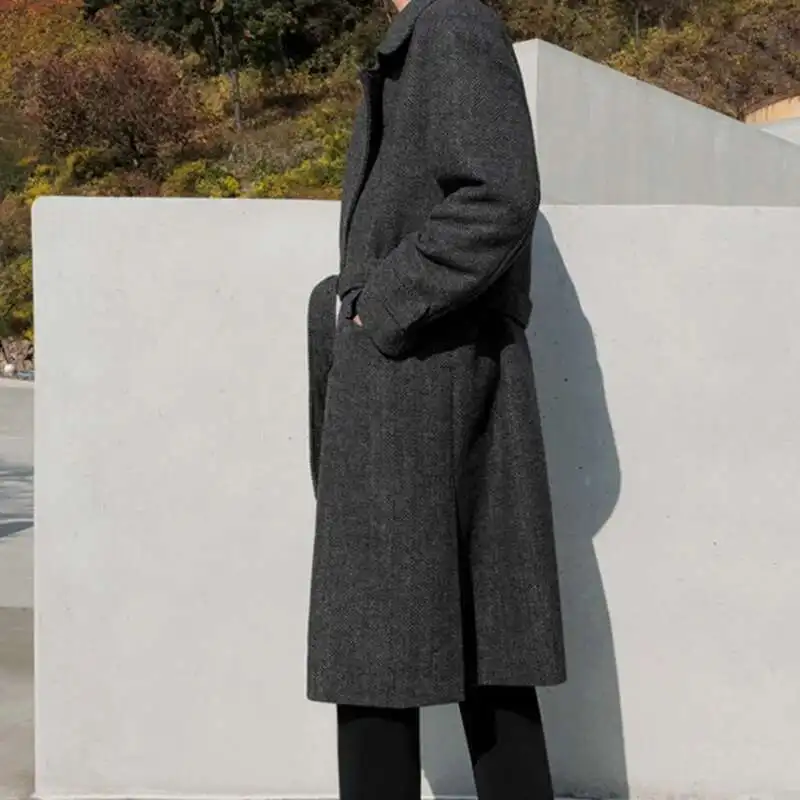
Is a Black Overcoat Appropriate for All Suit Colors?
The black overcoat holds a position of formality and versatility in men’s outerwear, but its universal appropriateness is nuanced rather than absolute.
Black overcoats pair exceptionally well with:
– Black suits, creating a seamless monochromatic look
– Charcoal and mid-gray suits, providing subtle contrast
– Navy suits, offering classic color theory contrast
– Pinstriped formal suits, complementing traditional business attire
However, certain combinations warrant reconsideration:
– Light brown or tan suits often appear disconnected from black outerwear
– Vibrant blue suits may create too stark a contrast for conservative environments
– Seasonal summer suits in lighter colors generally pair better with navy or tan coats
For maximum versatility across your suit collection, navy or charcoal overcoats often provide more harmonious integration with varied suit colors. If your wardrobe consists primarily of gray and blue suits, however, a black overcoat offers nearly universal compatibility within this focused color palette.
How Much Roomier Should Your Coat Be to Fit Over a Suit?
Achieving the perfect balance between accommodation and excess is crucial when selecting a coat for wear over suits. The coat must provide sufficient room without appearing oversized or compromising its own lines.
For most men, the optimal sizing follows these guidelines:
– Chest measurement: Add 2-4 inches beyond your suited chest measurement
– Sleeve length: Add approximately ½ inch beyond your suit sleeve length
– Shoulder width: Add ¼-½ inch beyond your suited shoulder measurement
Signs of proper fit include:
– Ability to comfortably button the coat while wearing a suit
– Freedom of arm movement without pulling or restriction
– No horizontal stress lines across chest or upper back
– Collar sits flush against neck without gapping
Common alterations that can optimize coat-over-suit fit include:
– Sleeve lengthening to accommodate suit sleeves
– Slight waist suppression to prevent billowing effect
– Button repositioning for optimal closure over suit jacket
Understanding how to find the perfect coat length for your body type helps ensure proportional fit that flatters your frame while accommodating your suits.
Are Seasonal-Specific Coats Necessary for Suit Wearers?
The question of whether to invest in multiple seasonal coats or seek one versatile option depends on your climate, professional needs, and budget considerations.
In variable climates, a strategic seasonal approach offers significant benefits:
– Winter: Heavy wool overcoats (20-24 oz) provide necessary warmth for freezing conditions
– Transitional seasons: Lighter weight topcoats offer appropriate protection without overheating
– Rainy seasons: Water-resistant options like trench coats protect suits from moisture damage
For professionals in relatively stable climates, a single high-quality coat in an appropriate weight for local conditions may prove sufficient. Those in more extreme environments benefit from dedicated seasonal options that address specific weather challenges.
When considering fabric selection, understand that wool coats provide excellent warmth while maintaining professional appearance. The specific wool weight should align with your typical winter temperatures—heavier for colder regions, lighter for moderate climates.
For those building a coat collection, consider prioritizing versatility in your first purchase, then adding specialized options as budget permits. A classic navy or charcoal wool overcoat in a medium weight offers the broadest utility for most business professionals.
Frequently Asked Questions About Coats Over Suits
Should coat color match suit color exactly?
No, exact matching often appears contrived. Instead, seek complementary relationships—navy or charcoal coats work with most suit colors, while black pairs best with darker suits.
Can I wear a suit jacket as my outer layer?
Suit jackets lack the necessary weight, lining, and weather protection to serve as outerwear. They’re designed specifically as part of a matched ensemble rather than standalone protection.
How should coat sleeve length relate to suit sleeves?
Coat sleeves should extend approximately ½ inch beyond suit sleeves, allowing a glimpse of the suit cuff while providing adequate coverage.
Is it acceptable to wear a coat unbuttoned over a suit?
Yes, particularly when moving between indoor and outdoor environments frequently. However, for longer outdoor periods in cold weather, buttoning provides proper warmth and presents a more polished appearance.
Can overcoats be tailored like suits?
Absolutely. Common alterations include sleeve length adjustment, waist suppression, and button repositioning. Working with a tailor experienced in outerwear ensures modifications maintain the coat’s integrity and function.
Should my scarf match my tie when wearing an overcoat?
Coordination rather than exact matching creates sophisticated harmony. Complementary colors or patterns that reference elements of your tie often create the most refined appearance.

